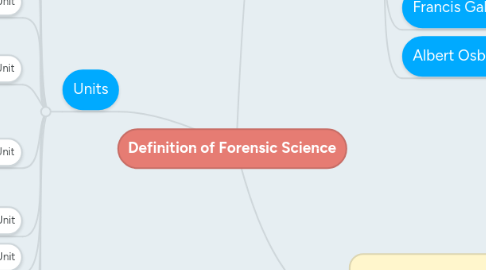
1. Units
1.1. Physical Science Unit
1.1.1. Identifies
1.1.2. Compares
1.2. Biology Unit
1.2.1. Blood samples
1.2.2. Body fluids
1.2.3. Hair
1.2.4. Fiber
1.3. Firearms Unit
1.3.1. Discharged bullets
1.3.2. Cartridge cases
1.3.3. Shotgun shells
1.3.4. Ammunition
1.3.5. Discharged bullets
1.4. Document Examination Unit
1.4.1. Handwriting analysis
1.4.2. Other questioned document issues
1.5. Photography Unit
1.5.1. Photographic techniques
1.5.2. To record and examine physical evidence
1.6. Toxicology Unit
1.6.1. Examines body fluids & organs for ..
1.6.1.1. Drugs
1.6.1.2. Poisons
1.7. Latent Fingerprint Unit
1.7.1. Processes
1.7.2. Examines
1.7.3. Fingerprints
1.8. Polygraph Unit
1.8.1. Lie detector
1.9. Voiceprint Analysis Unit
1.9.1. Ties recorded voices to particular suspects
1.10. Crime Scene Investigation Unit
1.10.1. Dispatches specially trained personnel
1.10.2. Collect and preserve physical evidence
1.11. Special Forensic Science Services
1.11.1. Forensic Psychiatry
1.11.1.1. Behavior
1.11.1.2. Legal proceedings
1.11.2. Forensic Odontology
1.11.2.1. Identification
1.11.2.2. Unrecognizable state
1.11.2.3. Bite marks
1.11.3. Forensic Engineering
1.11.3.1. Failure analysis
1.11.3.2. Accident reconstruction
1.11.3.3. Causes and origins of fires or explosions
1.11.4. Forensic Computer and Digital Analysis Unit
1.11.4.1. Digital evidence
2. People
2.1. Mathieu Orfila
2.1.1. Father of forensic toxicology
2.2. Alphonse Bertillon
2.2.1. Mugshot
2.2.2. Body measurements
2.3. Leone Lattes
2.3.1. Bloodtype
2.4. Calvin Goddard
2.4.1. Comparison of bullets
2.5. Walter McCrone
2.5.1. Analytical methods
2.6. Hans Gross
2.6.1. Scientific Principles
2.7. Edmond Locard
2.7.1. Locard's Exchange Principle
2.7.1.1. Cross-transfer
2.8. Sir Alec Jeffreys
2.8.1. DNA Profiling test
2.9. Francis Galton
2.9.1. Fingerprints
2.10. Albert Osborn
2.10.1. Document examination
3. The Crime Lab
3.1. Crime Laboratories
3.1.1. Rapid growth
3.1.2. Lack of planning and coordination
3.1.2.1. Regional
3.1.2.2. National
3.1.3. 350 labs
3.1.4. Different levels
3.1.4.1. Federal
3.1.4.2. State
3.1.4.3. County
3.1.4.4. Municipal
3.1.5. Evidence technicians
3.1.5.1. 24/7
3.1.5.2. Available for evidence collection at a crime scene
3.1.6. If no formal training exists - education, tours & manuals are available

